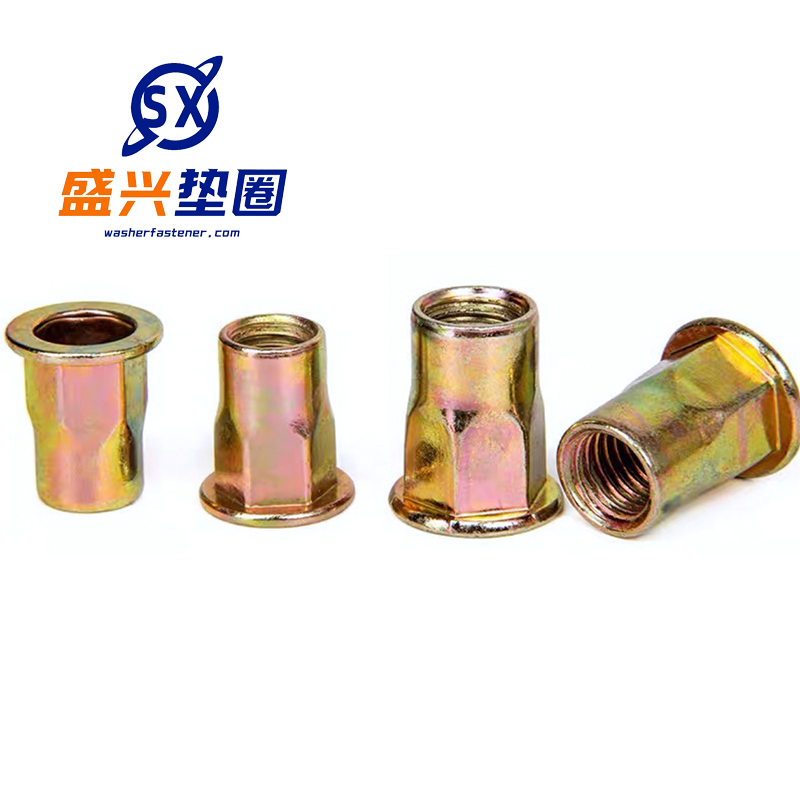
PRODUCTS
Pressure rivet nuts
Function -Efficient connection: Through riveting technology, nuts can be quickly and firmly connected to thin plates and other materials without welding or tapping, improving assembly efficiency. In electronic product assembly, the nut can be quickly pressed and riveted onto the thin plate of ...
Description
marker
Function
-Efficient connection: Through riveting technology, nuts can be quickly and firmly connected to thin plates and other materials without welding or tapping, improving assembly efficiency. In electronic product assembly, the nut can be quickly pressed and riveted onto the thin plate of the circuit board to achieve connection with other components.
-Provide reliable threaded connections: Provide standard internal threaded connections for bolts and other components to ensure stability and reliability of the connection, withstand certain torque and tension, and ensure that the connection between components is tight and not loose.
-Enhance the strength of thin plate connections: For thinner plates, rivet nuts can increase the strength and load-bearing capacity of the connection points, disperse pressure, and avoid deformation or damage of the plate due to excessive local pressure. For example, riveting nuts on thin sheets of car bodies can improve the overall strength of the body structure.
-Convenient disassembly and maintenance: The threaded connection method of the rivet nut makes the disassembly and maintenance of components convenient. The bolts can be easily unscrewed for component replacement or maintenance without damaging the board.
Purpose
-Electronic and electrical industry: widely used for connecting components such as casings and circuit boards of electronic products such as computers, mobile phones, and televisions, such as fixing batteries inside mobile phones and connecting circuit boards.
-Automotive manufacturing industry: used for connecting parts such as car bodies, interior parts, engines, etc., such as installing car seats and fixing instrument panels, which can meet the requirements of efficient assembly and high-strength connection in automotive production.
-Aerospace field: It plays a role in the connection of aircraft interiors, structural components, etc., and can meet the strict requirements of lightweight and reliability in the aerospace field while ensuring connection strength.
-Hardware products industry: Used for connecting and fixing components in various metal furniture, doors and windows, kitchen and bathroom equipment, such as installing hinges on furniture and fixing handles on doors and windows. product grade
-Grade A: High precision, strict dimensional tolerance control, good surface quality, suitable for applications with high requirements for connection accuracy and reliability, such as aerospace, high-end electronic equipment manufacturing, and other fields.
-B-class: slightly inferior in accuracy and quality compared to A-class, capable of meeting the connection requirements in general industrial production, commonly used in industries such as general machinery manufacturing and automotive parts production.
Material performance grade
-Carbon steel material: commonly available in grades 4.8 and 8.8. 4.8 grade carbon steel rivet nut, with a nominal tensile strength of 400MPa and a yield strength ratio of 0.8, suitable for connection applications with general strength requirements; 8.8 grade carbon steel rivet nut, with a nominal tensile strength of 800MPa and a yield ratio of 0.8, is commonly used in mechanical connections with high requirements for strength and reliability.
-Stainless steel material: commonly labeled as A2-70, A4-80, etc. The "A2" in A2-70 represents the second group A2 material of austenitic steel, and "70" represents the performance grade of the product, with a nominal tensile strength of 700MPa; The tensile strength of A4-80 is 800MPa, which has better corrosion resistance and is suitable for harsh corrosive environments.























